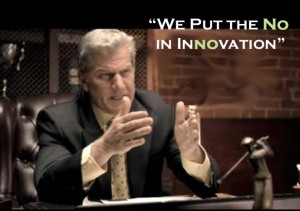I just wrote the stupidest article about social media. It’s stupid and proud, and if you don’t read it… “you don’t get it.”
Tag Archives: social
What is Social Media? Um… Just Watch This and Shut Up
Hours ago I had someone tell me they didn’t know what social media was today. My brother-in-law told me his competitors are using Twitter, and looked at me like he’d just seen a pig fly. Then I stumble into this video.
And I’m, like, yoooooo…. this is the stank baby. This is social media. Oh yeah, oh yeah. The revooolution. Right here. Right now.
Why Agencies Are Killing Social Media & What You Can Do About It
Rapport-building anecdote to engage you: Around 1999, I worked as an account manager at a website-development company called Frontier Media Group. It was a company that specialized in production of online-properties and kiosks. My biggest client (which became the company’s second largest) began treating us like its “Internet Agency of Record,” and that took us far beyond project work. It was a vote of trust, and suddenly we were being asked to evaluate media buys and pilots. “What should the ratio of my Internet budget be in terms of web build versus online advertising?” they’d ask. I rushed back to the shop and pleaded my agency’s senior leadership to develop online media-buying services to handle display advertising and paid search… they resisted for more than a year, finally compelled less by duty and more by the incremental revenue it could snatch. “Hmmmm. A chance to snatch five percent of digital spending that was increasingly going online.” They hired a media guy whose job it was to battle offline media agencies who, of course, saw this internet-advertising fad as a horrific waste of money (which only coincidentally cannibalized their billings, but I digress).
Now, a decade later, social media is facing a similar fate. As a marketer and independent consultant I see great opportunities that brands may not realize for years. As a former Internet agency guy, I understand why. It’s simply not yet profitable for an agency to engage in social media. Some account managers recommend social media, either because they know it’s in the brand’s best interest or they want to show they’re innovative. If the marketer appreciates the value, they’ll be heroes to the brand… even if they’re likely to be perceived as “going native” on their own agency. Why? Most savvy internet agencies haven’t figured out how to capitalize on emerging forms of social media, and urge clients to do things in their self interest. 
Interactive agencies — and their big ol’ parental full-service agencies, to which I shall refer as Big Agency — are typically made up of account teams, production people, planners, media buyers and creative. They shout “teamwork and synergy” when they pitch, and they despise each other secretly. Each of these silos has its hands full managing such mundane tasks as updating a website or doing insertion orders for a fat & juicy digital media spend. These tasks are profitable. The account team, often the only one who may directly benefit from a social-media pilot because they’ll look progressive to their client, have precious few resources to actually manage even a simple social-media campaign. Who at the agency has done a video contest, a YouTube promotion, a Facebook or Twitter campaign? Who can help substantiate much less manage something new? Oh- there’s someone who did it… but he’s busy with new-business pitch.
Meanwhile, Big Agency has very little incentive to partner with firms that specialize in social media (instead deferring to a full utilization of all agency personal before considering “outsourcing”). That’s consulting or agency-management 101… keep people “off the beach” even if their skills aren’t a good fit this particular decade. The specialist firms are, therefore, unable to get a seat at the table. “We don’t need them for that,” says the Big Agency chief creative officer or senior media buying executive. “We can do that ourselves!”
The result is that the “social media” campaigns are often a failure. And so, it seems, the medium is too. But to paraphrase British Author G.K. Chesterton (and Bruce Grant, who paraphrased him in his own way):
“Social media has not been tried and found wanting. It has been found difficult, and left untried.“
Examples:
- Bloated destinations on Facebook or Twitter that lack any relevant consumer engagement.
- Little appreciation for “earned” engagements (not paid) because media buyers aren’t media engagers. They’re buyers.
- Dismissive reactions to leveraging popular social-media “stars” because the agency sees that as a creative threat. The turtleneck-wearing, cigarette-holding creative director is insulted by letting their brand near an amateur YouTube star even if that chump has a bigger and more vibrant audience than will any professionally produced ad.
If an Internet firm or Big Agency can’t profit from social media (and sees it as a risk), how hard will they push it? Does an account guy want to take a risk for his client, only to be slapped around by 5 departments at his own employer? Will that Big Agency junior social-media advocate with skill and experience ever have an opportunity to help the agency, much less a client, tap the medium?
Meanwhile, the PR firms (who are instinctively appreciative of “earned” media that is so valuable in social media) are often not invited to contribute. These guys can’t spell HTML and didn’t have a Twitter account until it was all over the Wall Street Journal and NBC. If they do employ a social-media expert, the poor sap has the same fate that “web monkeys” held in PR and traditional agencies in 1999. They lack access to the clients, are not participating at a strategic level, and don’t even play nice in the agency sandbox.
This is a sad post, so let’s cheer it up and make it actionable. What can Big Agency (and even the nimbler ones) do to avoid these legitimate traps?
- 101 course for every department. Just like everyone at a traditional agency should have a basic understanding of the Internet, so too should they appreciate new forms of media. Not everyone needs to “tweet,” but they should be able to describe a successful case study related to each major media form (Twitter, Facebook, YouTube, Digg, and whatever else comes along). They may discover that “social media” can help their department instead of threaten its existence.
- Senior champion required. Every agency needs a senior advocate for these innovative new solutions that might otherwise die. His or her job should be to champion these and determine how the agency handles them. Should the media department handle social media, or does it fit better in the strategic, research, or planning group? I’ll give you a hint- this decision is the most vital.
- Take small innovation team off billable clock. Someone or a small group should be relieved of billable-hour pressure to identify emerging models — some that may not yet have a profit model, but can help a client’s business. This person or team should share best practices, and know what firms, vendors, consultants solve various problems. In some cases, they can simply educate account teams and connect them with these experts. But if it’s a first-attempt at what may be a high-maintenance project, this team might “run point” to manage the initiative from setting goals to collecting metrics. In many cases, it should educate account teams (and not just those pitching a new assignment), hand the project over, and return to collect the performance… ensuring it’s not redundant to other departments. Some of this work may have already been done on billable time, but if it’s buried in an account team it’s not going to help the new pitch or other client.
- Mutual profitability. Niche social-media players (startups and specialty firms) and the large agencies need to figure out how to partner in a mutually beneficial way, and that takes more than driving great results for a client. The “vendor” and the agency both need to have a clear role and profitability. For instance, if Buzzmetrics is better than the agency’s homegrown “web monitoring” solution, than outsource and mark it up (by adding value on the output). If some weird Twitter guru freelance consulting can offer some guidance, give them a seat early and define their boundaries. The freak’s input may help optimize a program, kill it justifiably, or save it from becoming an embarrassing headline.
- Pick wisely. Social-media startups (and especially consultants) are sometimes brilliant solo players, but don’t know how to do the jazz ensemble. Others have decided to pursue a niche passion, and have no interest in doing things outside that realm. If Big Agency senses a specialist firm or company wants to be a full-service agency, then one can understand why Big Agency wants them far from their clients.
- Make a black & white list. In emerging forms of advertising, there will be winners and losers related to both the medium and the people that executed a program. An agency needs to keep tabs on vendors and programs that succeed and fail. That means tracking both the performance of the medium (YouTube) AND the partner (an online-video specialist) that managed the assignment. A success is probably indicative that both are solid. But a failure could mean one or the other, and knowing the right answer will be important to determine if another attempt is made.
- Timing is everything. On one hand, few want to be the first to pilot something new, where it’s hard to predict outcomes much less scope time it will take. When an agency has trouble and a simple project gets bloated, it either needs to reevaluate how it did it… or determine that it’s a cost-prohibitive tactic because of the manpower it consumes. On the other hand, by the time it’s 100% clear that a social-media tactic will work, it’s probably an antiquated one. There’s an old African proverb: “if you wait for the whole beast to appear before throwing the spear, you’re already too late”).
Now I invite you, dear agency and brand readers, to provide your own thoughts (anonymously if you choose, as WordPress can’t track your ISP). You’re so very quiet on this blog that I sometimes worry you’re not reading. Please share! Otherwise I’m only writing for the fun regular commenters I call the WVFF back row.”
Does That YouTube Video Help or Hurt Your Brand? The Peeps Decide.
You can decide whether a random YouTube video helps or hurts a brand, simply by voting on YouTube Brandwatch (see link). Vote on videos about laptop wedgies, Bic lighter tricks, or sexy Sprite. (Source: YouTube Biz Blog).
Read YouTube’s interview with Matthew Yeomans and Bernhard Warner, directors of Custom Communication.
The blog is an outgrowth (code for promotional vehicle) of the duo’s Social Media Influence Conference, to which Nalts Consulting hasn’t yet been invited. 🙂
Social-Media Monitoring in Real Life: 9 Beaches
So here’s a real-time gold-standard case study of social-media monitoring and action in just hours.
We’re at this 9Beaches resort in Bermuda (wifeofnalts found it via The Today Show and it’s far more casual and affordable than most places in Bermuda).
I did a small video this morning on my responseofnalts channel, and was planning on doing a better Bermuda video recap in the next couple days for the Nalts channel. I wanted to get rights to the song from 9Beaches website first (do do do do doooo).
The cell phone rang after my afternoon nap, and it was the 9 Beaches general manager. Seems his US agency, Madigan Pratt & Associates had picked up the video presumably through monitoring technology or alerts. He was going to invite us back to the resort, until he realized we were still here. The rest of this story is in this video.
Ironic that I’ve been writing about video for 3 years and never used vlogging to do a blog post here, eh?
So You Want to Be Social-Media Cool?
I’m going to give you a free social-media makeover here, folks. I may not live in social media Heaven, but I’ve had a few “follow the bright light” moments, and have returned with some important messages from Above.
- First- get on Twitter. Microblogging short sentences from the web or your text-enabled phone may seem pointless, but that’s only if you haven’t learned to “follow” anyone who has a cooler life than you. Lie about what you’re doing so people don’t think you’re pathetic. I have more than 1,000 people following me, so that gives my life meaning.
- Now up the game with 12secondtv.com. Follow me. I’ve found I can make 12-second videos from my cell phone while driving. No pesky editing.
- Start ChaCha’ing instead of Googling remotely. Just text any question to 242242, and you get an instant answer. Sometimes they’re not in the mood to write back, but it’s still fun to say.
- Text. Seriously if you don’t text you might as well buy a Brother typewriter and get off the computer. SMS stands for short message um.. something. And then there’s MMS or something. It’s for multimedia. Just text. Or RSS.
- Oh, you think you’re better than me because you’ve been texting for ages? Well screw off. I Jott. You heard me. I call a toll-free number and it transcodes my speech to text for free. Jott can send my spoken words as text to wordpress or twitter or to my administrative assistant Sandy.
- Get iwantsandy. Have no idea what the hell Sandy does, but she’s an administrative assistant. And my real admin happens to be a woman who works in the union and also is named Sandy. She likes crystals. The electronic Sandy has a retro logo.
- Join vloggerheads. You need an invite, and so you’d better contact Nutcheese or someone cool. This is Renetto’s mutiny from YouTube. I showed up yesterday and it was like an insanity floor for disturbed YouTubers. They gave me some orange pills and made me right at home.
- Join Amazon Prime. You get free two-day shipping not to mention social status. Just drop on Twitter or Vloggerheads and say “yeah- I’m Amazon Prime.” What are you? Amazon Light? Whatever. Oh by the way- I get 12 dollars if you join from this link, and there’s a 1 month free trial. Just shut up and join.
- Join iamintown. Oh sorry- that’s in a special beta release. You’ll have to wait.
- Play with FriendFeed. Mine is kinda sparse but you can check out Steve Rubel’s (he’s the vlogger behind micropersuasion). Steve Rubel is on top of new trends even if he doesn’t link to me anymore.
- Watch some of the live shows on blogtv.com. I’m on Sunday nights at 9. Here’s my new account (Nalts) but 105 people are subscribed to my RealNalts account, which I had created when I couldn’t get Nalts.
That’s all you can handle right now. From your perspective, Jott will be a game changer. From my perspective, I just want you to join Amazon Prime because I’ve made about $4 in the past three months on my DVD sales, t-shirts, and stupid ads on kevinnalts.com. You don’t think I’m blogging for f’ing fun do you? Shit I need some flashy porn banners on this blog.
50 Things Marketers Will Ignore About Social Media
Oh you stupid marketer. I can’t even believe you found this blog post. You’re so stupid.
I can’t even help you right now. But Chris Brogan can. He’s got a list of 50 ways a marketer can use social media. Why don’t you go read it so you can make sure you don’t accidentally do any of them.
Murketing is a New Word. Let’s Use it Correctly.
NewTeeVee refers to Rampenfest as murketing and Newsweek recently used the term to refer to the BWM GINA campaign.
I may be wrong, but I believe murketing is starting to be used to refer to the “advertorial-like” corruption of marketing and entertainment. That’s not its origin. The fairly new term was coined by Rob Walker in his book, Buying In: The Secret Dialogue Between What We Buy and Who We Are). Murketing refers to being vague — not deceptive or lacking transparency.
Whether NewTeeVee or Newsweek meant to tweak murketing’s definition isn’t important. We still need a term for advertising that pretends to be something else. Let’s agree to a word — and Wickipedia better damned well credit me for this because I’m making them up right now on Thursday, June 26 at 12:05. Frankly I’m disappointed that a marketer has to create this instead of some PETA-like anti advertising group.
The word should point to the futile attempts that brands have made to promote through social media and video, but not be transparent or honest. It’s branding, but pretending to be entertainment. It almost invariably results in backlash, and it’s quite worse than advertorial (the unhealthy blend of editorial content that is funded by advertisers). It’s the topic of my “CashtoBuzz” parody last year. It was brought to mainstream when a PR firm was exposed for being a silent creator to an anti-Gore penguin parody.
So here are a few shots:
- Masqueradvertising
- Trojan horse marketing
- Amway Friend
- Benedict Arnold entertainment
- Rose by Another Name
- Advertainment
- Enteradvertising
- Grim Reaper with a Propeller Hat
- Snowmotion
I need some more caffeine to improve these. Feel free to develop it yourself. I won’t steal your word without feeling guilty. After all, I’m a murketer.
What is Social Media?
 I met the Marketing Diva (Toby Bloomberg) at a Cox Communications event. She pulled out her Flip cam and asked me to define social media. So I gave her a quick answer. Then along comes “The 60 Second Marketer” and packages this spontaneous clip into the following video called “What is Social Media.” Suddenly, my “pull it out the bum” verbal exposition looks rather comprehensive and definitive.
I met the Marketing Diva (Toby Bloomberg) at a Cox Communications event. She pulled out her Flip cam and asked me to define social media. So I gave her a quick answer. Then along comes “The 60 Second Marketer” and packages this spontaneous clip into the following video called “What is Social Media.” Suddenly, my “pull it out the bum” verbal exposition looks rather comprehensive and definitive.
Let’s explore what makes this clip so trustworthy:
- Logo at the beginning
- Cool voice over
- Simple delivery
- Sponsored content
- Nice look/feel
I think the next time I decide to represent my random opinion as fact, I’m going to proceed and follow it with Slater doing a deep, rich voiceover that summarizes it.
Oh Dear. I’m a Social-Media Neanderthal. Again.
Do you know that sickening feeling when you realize something important is happening via social media, and you don’t know where to start? You may call me a Neanderthal, but I like to think I’m a “medium-fast follower.”
So here’s my social media “Keeping Up With the eJones” history (at a Glance):
- In 1991 my friend Damon put his e-mail address on his business card, and I laughed.
- I can’t remember anything that happened between 1991 and 2005, but they tell me there was a bubble.
- In the fall of 2006, the techies in my office suggested I post videos on YouTube. I was like, “whatever. Revver shares advertising revenue.”
- I think I discovered Linked-In around then, and have been plagued by former salespeople since. Still can’t decide if I should be Kevin Nalty (marketing guy) or Kevin Nalts (video junkie).
- In 2007 I went on SecondLife for the first and last time (made this short satire video of my experience)
- Later in 2007, I felt compelled to catch up with my cooler friends by joining Facebook, MySpace, and other stupid social media sites I can’t even remember.
- I even started Twittering last year because Micki Krimmel made it look hot.
- Nutcheese told me to start Stumbling the other day, and that pretty much killed my video-making proliferation the past week. Thanks, Kelley.
- Now Steve Rubel (the “all knowing Thumper in a forest of clueless Bambninos“) is telling me I need to FriendFeed because he’s addicted. Of course some jackass swiped the Nalts name on FriendFeed (the nerve), so I had to resort to RealNalts. I don’t know how to start Friendfeeding, but the Scobleizer says it’s fast. Now I just have to figure out what it does fast.
- Continue to get accosted by work, friends and family about never checking e-mail and allowing my voicemail box to say “full.”
How’s a girl supposed to keep up with friends, coworkers and family? I’m too busy harnessing new technology to simplify my life.





